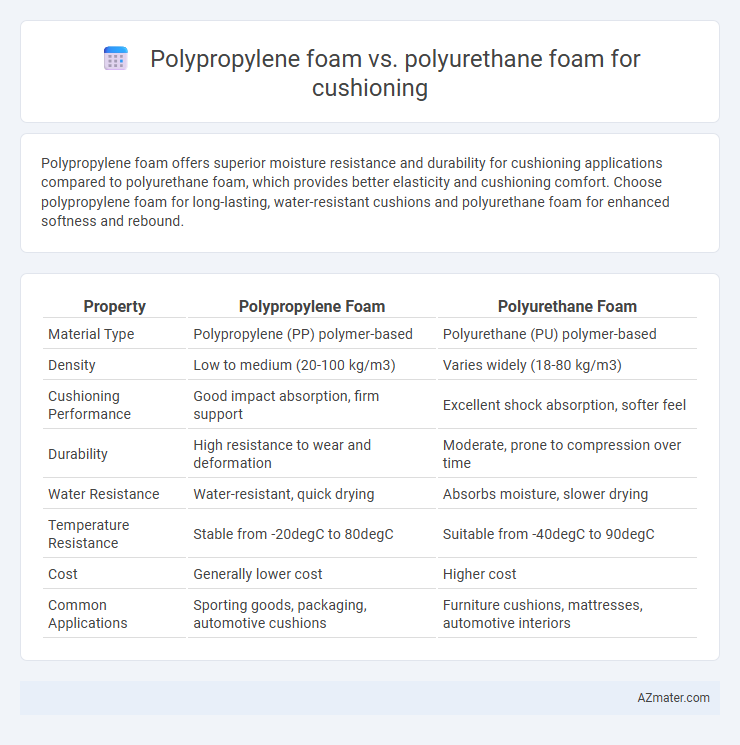Polypropylene foam offers superior moisture resistance and durability for cushioning applications compared to polyurethane foam, which provides better elasticity and cushioning comfort. Choose polypropylene foam for long-lasting, water-resistant cushions and polyurethane foam for enhanced softness and rebound.
Table of Comparison
| Property | Polypropylene Foam | Polyurethane Foam |
|---|---|---|
| Material Type | Polypropylene (PP) polymer-based | Polyurethane (PU) polymer-based |
| Density | Low to medium (20-100 kg/m3) | Varies widely (18-80 kg/m3) |
| Cushioning Performance | Good impact absorption, firm support | Excellent shock absorption, softer feel |
| Durability | High resistance to wear and deformation | Moderate, prone to compression over time |
| Water Resistance | Water-resistant, quick drying | Absorbs moisture, slower drying |
| Temperature Resistance | Stable from -20degC to 80degC | Suitable from -40degC to 90degC |
| Cost | Generally lower cost | Higher cost |
| Common Applications | Sporting goods, packaging, automotive cushions | Furniture cushions, mattresses, automotive interiors |
Introduction to Cushioning Materials
Polypropylene foam offers lightweight, moisture-resistant cushioning with excellent impact absorption, making it ideal for packaging and sports equipment. Polyurethane foam provides superior elasticity and comfort, commonly used in furniture and bedding due to its ability to conform to pressure points. Both materials serve distinct cushioning needs based on durability, density, and application environment.
What is Polypropylene Foam?
Polypropylene foam is a lightweight, closed-cell material known for its excellent chemical resistance and high durability, making it ideal for cushioning applications requiring long-term performance. Its rigid structure provides superior support and impact absorption compared to polyurethane foam, which is softer and more elastic. This foam's moisture resistance and thermal insulation properties make it a preferred choice in automotive and packaging industries where durability and stability are critical.
What is Polyurethane Foam?
Polyurethane foam is a versatile, open-cell or closed-cell polymer widely used for cushioning due to its excellent elasticity, durability, and shock absorption properties. It offers superior comfort and support by conforming to body shapes, making it ideal for furniture, mattresses, and automotive seating. Compared to polypropylene foam, polyurethane foam generally provides better resilience and energy absorption, enhancing its cushioning performance in various applications.
Physical Properties Comparison
Polypropylene foam offers high resilience, low density, and excellent moisture resistance, making it ideal for lightweight cushioning applications compared to polyurethane foam. Polyurethane foam provides superior elasticity, higher compression set resistance, and better energy absorption, which enhances comfort and durability in furniture and automotive seating. Both materials differ significantly in thermal insulation and chemical stability, with polypropylene foam excelling in heat resistance and polyurethane foam showing greater versatility in hardness and firmness options.
Cushioning Performance and Comfort
Polyurethane foam offers superior cushioning performance with higher resilience and excellent energy absorption, making it ideal for comfort-focused applications like seating and mattresses. Polypropylene foam provides a lighter, more rigid cushioning solution with good indentation resistance but generally less softness and conformability than polyurethane foam. For enhanced comfort and pressure distribution, polyurethane foam remains the preferred choice due to its superior elasticity and cushioning properties.
Durability and Longevity
Polypropylene foam offers superior durability and resistance to moisture, making it ideal for long-lasting cushioning applications where exposure to water or chemicals is a concern. Polyurethane foam provides excellent comfort and cushioning but tends to degrade faster under repeated compression and exposure to heat or UV light. For extended lifespan and durability, polypropylene foam is generally preferred in high-use or outdoor cushioning environments.
Environmental Impact and Sustainability
Polypropylene foam offers superior environmental benefits compared to polyurethane foam due to its recyclability and lower carbon footprint during production, making it a more sustainable choice for cushioning applications. Polyurethane foam, derived from non-renewable petroleum-based resources, often contains toxic additives and is less biodegradable, leading to increased environmental pollution and disposal challenges. Choosing polypropylene foam supports circular economy principles by enabling easier recycling and reducing long-term waste accumulation in landfills.
Cost Efficiency and Availability
Polypropylene foam offers higher cost efficiency compared to polyurethane foam due to its lower production expenses and longer lifespan, making it a budget-friendly option for cushioning applications. Polyurethane foam is widely available and known for superior comfort and flexibility, but its higher cost and tendency to degrade faster can increase long-term expenses. Availability of polypropylene foam is growing in various industries, enhancing its appeal for large-scale, cost-sensitive cushioning solutions.
Common Applications in Cushioning
Polypropylene foam is widely used in cushioning applications such as packaging, automotive seating, and sports equipment due to its lightweight, durability, and excellent moisture resistance. Polyurethane foam is preferred for furniture cushions, mattresses, and automotive interiors because of its superior comfort, flexibility, and impact absorption properties. Both materials serve vital roles in cushioning, with polypropylene offering structural support and polyurethane providing enhanced softness and resilience.
Which Foam is Best for Your Cushioning Needs?
Polyurethane foam offers superior cushioning with excellent flexibility, resilience, and durability, making it ideal for high-impact and long-term use scenarios. Polypropylene foam provides lightweight, moisture-resistant, and chemical-resistant benefits, which suit applications where water exposure and lighter weight are priorities. For comfort and support in furniture or automotive seating, polyurethane foam is often best, while polypropylene foam excels in outdoor or moisture-prone environments.

Infographic: Polypropylene foam vs Polyurethane foam for Cushioning
 azmater.com
azmater.com